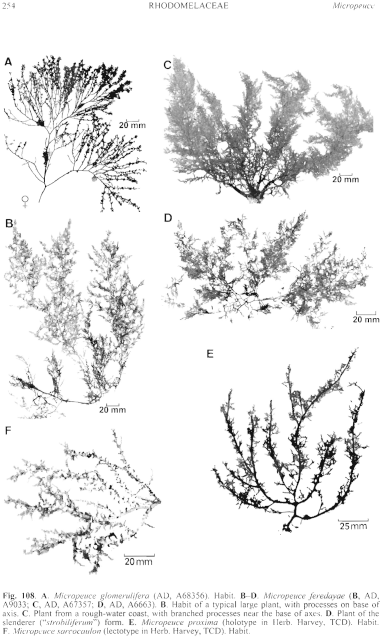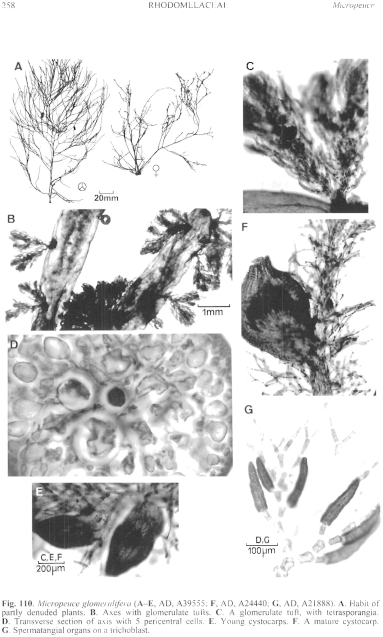|
|
|
|
|
|||||||||||
|
Electronic Flora of South Australia Species Fact Sheet
Phylum Rhodophyta – Family Rhodomelaceae – Tribe Lophothalieae
Thallus (Figs 108A, 110A) medium to dark red-brown, 10–25 cm high, with one to a few branched, corticated, main axes 1–3 mm in diameter, with long laterals bearing short, probably proliferous, tufts (Fig. 110B, C) uniformly 2–3 (–4) mm long, each with 1–3 branched axes bearing trichoblasts. Holdfast discoid, 3–10 mm across; epilithic. Structure monopodial, trichoblasts cut off from segments 4–8, with 5 pericentral cells (Fig. 110D) produced from about segments 12–13. Trichoblasts rhodoplastic, 500–800 µm long, with 3–4 branches 1 (–2) cells apart and upper branched filaments 3–5 (–7) cells long; basal cells 40–60 µm in diameter and L/D 1–2, mid cells 20–30 µm in diameter and L/D 2–3, terminal cells 10–15 µm in diameter and L/D 2–3; young trichoblasts tapering to slender ends with cells 5–10 µm in diameter and L/D 6–10. Cortication commencing close to apices, with the pericentral cells remaining clear in transverse section, inner cortical cells only slightly smaller than pericentral cells (Fig. 110D), then grading to smaller outer cortical cells, with intermixed smaller rhizoidal cells (sometimes between pericentral cells). Cells uni- (–2) nucleate; rhodoplasts discoid or in slight chains.
Reproduction: Gametophytes dioecious. Procarps borne on the suprabasal segment of trichoblasts, with it and the basal cells becoming polysiphonous. Carposporophytes with a basal fusion cell and slender, branched, gonimoblast filaments with elongate-clavate terminal carposporangia 30–50 µm in diameter. Cystocarps (Fig. 110E, F) ovoid with a swollen base and short, scarcely constricted, neck, (300–) 500–1200 µm in diameter and 600–1200 µm long; pericarp ostiolate, corticated. Spermatangial organs (Fig. 110G) as mid branches of trichoblasts, lanceoid, 150–300 µm long and 20–70 µm in diameter.
Tetrasporangia (Fig. 110C) in polysiphonous branches of lateral tufts densely covered with trichoblasts, spirally arranged with 1 sporangium per segment, fertile parts 0.5–1 mm long and 150–250 µm in diameter; tetrasporangia bulging the segments, 80–140 µm in diameter with 3 cover cells.
Type from Stinky Bay, Nora Creina, S. Aust., drift (Womersley, 3.ix.1971); holotype in AD, A39555.
Selected specimens: Port Elliot, S. Aust., drift (Womersley, 25.x.1958; AD, A21888). Robe, S. Aust., drift (Womersley, 24.viii.1960; AD, A24440). Nora Creina, S. Aust., drift (Womersley, 4.ix.1958; AD, A21526). Warrnambool, Vic., drift (G. & R. Kraft, 11.vii.1997; MELU, K10654; AD, A68356). Queenscliff, Vic., drift (Kraft & Doty, 30.viii.1971; MELU, K3870). Charlotte Cove, SE Tas., 9 m deep (Edgar, 6.x.1999; AD, A68348).
Distribution: Port Elliot, S. Aust., to Queenscliff, Vic., and SE Tasmania.
Taxonomic notes: M glomerulifera differs from M. feredayae in habit, with the short glomerulate tufts scattered along the branches; the trichoblasts of the former are also shorter than those of M. feredayae.
References: The Marine Benthic Flora of Southern Australia Part IIID
Publication:
Womersley, H.B.S. (24 February, 2003)
The Marine Benthic Flora of Southern Australia
Rhodophyta. Part IIID. Ceramiales – Delesseriaceae, Sarcomeniaceae, Rhodomelaceae
Reproduced with permission from The Marine Benthic Flora of Southern Australia Part IIID 2003, by H.B.S. Womersley. Australian Biological Resources Study, Canberra. Copyright Commonwealth of Australia.
Illustrations in Womersley Part IIIA, 2003: FIGS 108A, 110.

Figure 108 enlarge
Fig. 108. A. Micropeuce glomerulifera (AD, A68356). Habit. B–D. Micropeuce feredayae (B, AD, A9033; C, AD, A67357; D, AD, A6663). B. Habit of a typical large plant, with processes on base of axis. C. Plant from a rough-water coast, with branched processes near the base of axes. D. Plant of the slenderer ("strobiliferum") form. E. Micropeuce proxima (holotype in Herb. Harvey, TCD). Habit. F. Micropeuce sarcocaulon (lectotype in Herb. Harvey, TCD). Habit.

Figure 110 enlarge
Fig. 110. Micropeuce glomerulifera (A–E, AD, A39555; F, AD, A24440; G, AD, A21888). A. Habit of partly denuded plants. B. Axes with glomerulate tufts. C. A glomerulate tuft, with tetrasporangia. D. Transverse section of axis with 5 pericentral cells. E. Young cystocarps. F. A mature cystocarp. G. Spermatangial organs on a trichoblast.

|
Email Contact: State Herbarium of South Australia |

|